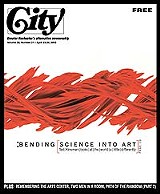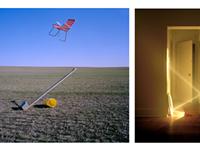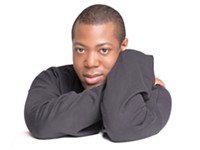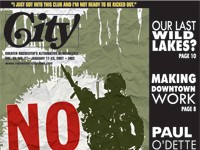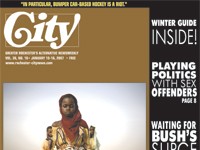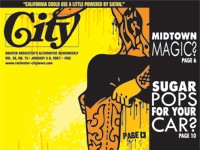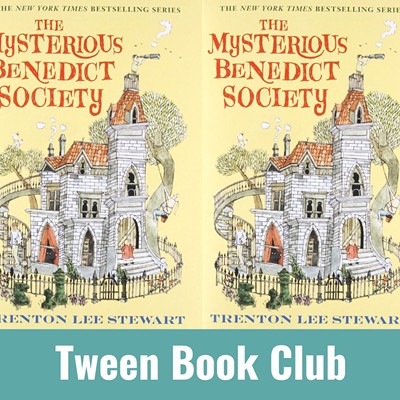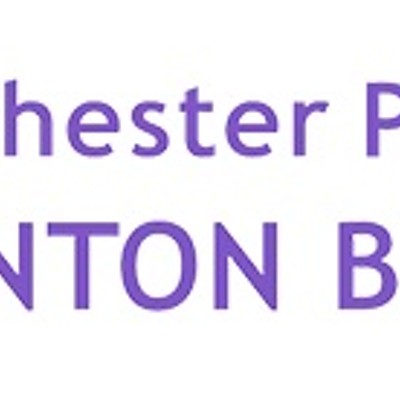[
{
"name": "500x250 Ad",
"insertPoint": "5",
"component": "15667920",
"parentWrapperClass": "",
"requiredCountToDisplay": "1"
}
]
After a long, harsh winter, the April ice storm was enough to leave most Upstate New Yorkers exasperated. But scientific photographer Ted Kinsman was having the time of his life.
"I shot 60 images on Friday morning; then I went out and shot another 200," Kinsman says. "It was very good. A lot of ice-covered stuff, power lines down. We didn't have a good winter last year. This past winter was great. The more snow the better. Bring it on!"
Kinsman, who teaches science at Brighton High School, has carved out a second career in stock photography. His current specialty: snowflakes.
"When I see it snow, I think, 'My God, that's money coming out of the sky!' Every one of those snowflakes; I'll be photographing until I can't even see straight. It's one o'clock in the morning, I can barely stand up, and it's still snowing. All my hard drives are full. I've taken 300 or 400 pictures. I close my eyes and I see snowflakes."
In a world where artists speak of purity of intention and preciousness of imagery, Ted Kinsman is something of an anti-artist. He creates absolutely stunning images, sometimes dozens in an hour, but he makes no claims of aesthetic value. And --- heaven forbid --- he speaks openly of his continuous desire to come up with something that will sell.
"You can go out and take great pictures but that's a very small part of photography. The big part is, you've got to sell the stuff," he says. "I could sell these to a science museum or, if I was smart, I would probably find a New York art gallery. Get other people to market it and you've got it made."
Chances are, you've already seen some of Kinsman's work. The time-lapse images of a rose blooming at the beginning of The Bachelor were shot in his basement. But you'd never know it; Kinsman gets no credit. Nobody recognizes his shots of microorganisms on a Lysol commercial, or his soap-film stills used as backdrops in Xerox and Texas Instrument ads. Do stock photography and nobody knows your name.
"I don't even see a lot of the places it goes," he says. "I sell to a stock house; the stock house sells to a producer; the producer sells to a client."
Still, somewhere along the line, Kinsman managed to impress his students with, of all things, pictures of salt crystals and a fetus. But that was only because they were used on CSI: Crime Scene Investigation.
"My students said, 'You did work for CSI!' You could win the Nobel Prize and it would be minor compared to CSI."
Kinsman, 39, lives with his wife Jennifer and two young children in Brighton. (Another child is on the way.) His father, who taught material engineering at Monroe Community College, was an amateur photographer. His mother is an artist specializing in stone mosaics. He has three brothers in technical fields and a sister who is studying to be a teacher.
"None of them ended up in the arts," he says. "I don't even know if I've ended up in the arts."
After earning a degree in optical technology from MCC in 1984, Kinsman spent some time as a bicycle mechanic in the Yosemite Valley before studying physics at the University of Oregon in Eugene.
He spent two years in Washington, DC's Naval Research Laboratories as a physicist and worked at Cornell University measuring the mass of unknown chemical compositions. After earning a master's degree in science education at Syracuse University, he took an optics job in Rochester.
It was while writing articles for Science Probe magazine sometime around 1990 that Kinsman got seriously involved in photography.
"You'd write about cool things and they always wanted photographs, so I got out my old cameras and started taking pictures of stuff," he says. "You'd get the paycheck from the magazine and it would itemize $500 for the article and $1,200 for the photographs. And you start to realize this isn't balanced, because the writing is a lot more work than taking pictures. I got the idea that if I could combine writing with pictures, I'd have a unique product without much competition."
Kinsman learned another valuable lesson when he wrote a physics textbook for science teachers in the early 1990s. The book had small sales but taught him about making one product and selling it many, many times.
He had just started his own publishing business when his brother Andrew brought over something he'd found tucked away in the far reaches of the Internet: dot patterns.
"He said, 'This is really cool --- you stare into these dot patterns and you can see 3D.' I said, 'We've got to write a book.' We spent the summer talking about it and put together a textbook."
Random Dot Stereograms, published under his brother's name, explained how these optical illusions can be constructed. Reviews were mixed.
One editor told Kinsman, "You're a moron! Who in the world would buy a book on sandpaper?"
There were small sandpaper-like dots on most of the pages. But there was literally more here than met the eye. As people began to understand what the book offered, the response grew more positive.
Kinsman was soon getting phone calls from people who would ask, "Can I buy a few cases? And how soon can you get them to me?" The book took off, and went through four printings.
Far from sandpaper, the Kinsman brothers' book provided the groundwork for the Magic Eye craze of the 1990s.
"We taught the world how to make random dot stereograms," he says. "Everybody that bought this book initially started their own publishing companies and put out posters. The posters sold like crazy."
So how come the Kinsman brothers didn't make a fortune?
"We didn't do it in color," he says. "We couldn't copyright it; it was invented in the 1960s. It was a pretty obscure technique that was floating around but nobody had applied really good mathematics and computer programming to it."
A stereogram appears to be a random dot pattern, but is actually a fusion of identical pixelated images viewed at different distances. Each eye sees a slightly different image and, when viewed correctly (in a somewhat cross-eyed or unfocused manner), a single 3D image emerges from the dots.
Does Kinsman regret the fact he provided the code that taught others how to get rich?
"No. That's what teachers do, isn't it? I'm still doing this with other technologies."
Though he and his brother did not make as much money as the publishers of the Magic Eye books and posters, they did well. Kinsman laughs about another benefit: All of the companies they helped start sent hundreds of posters.
"I have one of the best collections of random dot stereograms in the world!"
And the book attracted some fascinating buyers. Arthur C. Clarke, author of 2001: A Space Odyssey, called Kinsman from his home in Sri Lanka and said he wanted to buy some books. Kinsman, a big fan, sent him some, for free, and received a nice thank-you note in return.
Around that same time, Kinsman got a call from the head of Brighton Middle School's science department. Stressing that the stereogram craze was a passing fad, he convinced Kinsman to come in for an interview.
Kinsman began teaching at the middle school in the fall of 1993 and eventually moved to the high school.
Looking for a summer project, Kinsman turned back to photography in 1994. Like a good scientist, he did a systematic analysis of different forms of photography in an effort to "eliminate the competition." He settled on time-lapse photography, bought a camera, and rigged it with computerized controls so he could time the photographs.
Kinsman took pictures of flowers and insects. The need for new equipment led him to the conclusion that he'd better sell something. So he projected his results onto a screen in his kitchen and videotaped the time-lapse sequences. He sent the results to 10 stock houses; eight wanted to represent him.
It wasn't long before Kinsman began to understand the stock photo market. His agents wanted time-lapse traffic and time-lapse clouds for backgrounds in television commercials. Kinsman built bigger and bigger systems to shoot a variety of subjects.
Equipment often had to be modified. When Kinsman was asked to shoot ice crystals, he had to go out and buy a refrigerator.
"I go to Sears and go through all the specs and wattage and check it for vibration. The guy says, 'I haven't had anyone come in and buy a fridge and check it out as thoroughly as this.' I said, 'Yeah, I'm going to cut a 20-inch hole in the side.'"
Today, he says, anybody can buy a digital camera and create time-lapse images at little expense, but people still call Kinsman to provide images.
As for his trademark snowflakes, he shoots them in his garage.
"You collect them, photograph them, and then set them free again."
But not every snowflake is worth shooting. In fact, the perfect ones don't come down very often. Kinsman can count on maybe four of five days of wonderful snowflakes per year. If he calls in sick on a snowy day, don't be surprised to find the principal at Brighton High looking through a magnifying glass by his office window to see if this is one of Kinsman's "perfect" snow days. Kinsman has no doubts about the quality of his snowflakes.
"My goal was to corner the market in snowflake photography," he says. "I have the largest modern collection. Anybody who sees these, if they go out looking for a snowflake picture, they will buy these. They won't even touch anyone else's."
So who better to ask the big question? Is it true no two snowflakes are alike?
"I have a hard drive of 2,500 images. If I threw in a new one, you wouldn't know it. There are beautiful hexagonal snowflakes; you can't tell them apart. There are ice columns; they are all identical."
But there are some that are not only unique, but simply extraordinary.
"I saw this snowflake," says Kinsman, pointing to a magnificent picture, "and I said, 'Let's take about 30 pictures of that!'"
After all of this observation, Kinsman is even more in awe of the wonders of nature.
"It's amazing! Everything is amazing! You can photograph anything and show something unique about its structure. You've just got to look closely enough."
Not surprisingly, Kinsman has found the snowflake market to be somewhat seasonal. His latest call came from a museum in Latvia. It wants some snowflake photos, but doesn't have much money. Kinsman struck a trade: snowflakes for Russian dolls.
Kinsman's time-lapse photography is not confined to nature. He is one of the world's experts in the construction and maintenance of time-lapse photography systems, and has served as a consultant on every continent except Africa. He does most of this work over the phone, at a rate of $100 an hour. But he is available to go on-site for $1,000 a day.
Just for fun, he supervised a time-lapse film of a Monroe County Water Authority construction project that lasted for more than a year in Brockport. The result is a wonderful five-minute re-creation of the entire process.
Kinsman's time-lapse experiments have also led to some innovations, including his own variation on peripheral photography. The process, an old technique he stumbled upon, involves photographing a sequence all the way around the outside of an object.
In Kinsman's computer-generated variation, thin slices of up to 3,000 images are reconstructed to make an abstract whole. Through software he designed, a squash or pineapple become something otherworldly. An iris is transformed into an intriguing abstraction.
"Now I've got to sell them, so I can get more time-lapse equipment," Kinsman says, jumping back to the idea of doing one thing and selling it many times.
"I can do one set of time-lapse sequences and sell the time-lapse," he says. "Then I can apply this technique to the whole data set and sell it twice more. Then I can take that image, move it just slightly in time, take the difference between those two frames mathematically, and sell it again. Then you blow all the color away, apply false color, and sell it again. If I can find another way to sell it, I'll be there."
He'll try almost anything. When slides don't come out correctly, he'll "hit them with a match; you get beautiful patterns."
Kinsman holds up a series based on Queen Anne's lace, weaving and bobbing in time-lapse photographs.
"Time-lapse, especially biological time-lapse, is like a poor man's animation," he says. "I don't want to be sitting there moving a little plastic guy's head for every frame. Let the plant do it."
Where does most of this magic happen? A claustrophobic basement in Kinsman's house, crowded with equipment, plants, cameras, and computers.
Dominating the space is a Schlieren optical rig, a board with two giant lenses on either end held up by two tripods. A light beam shines through at one end. This contraption is normally used for visualizing air patterns around jet rockets in a wind tunnel; Kinsman will use it in a project that involves filming smoke.
Kinsman shows me around his basement, taking care not to jar a camera that's perfectly positioned to take time-lapse shots showing the growth patterns of castor beans.
In another area he pulls apart two carefully positioned strings to transform a drop of dishwashing soap solution into a rainbow of psychedelic paisley patterns.
His basement is full of microorganisms. He's got vinegar eels, microscopic animals that secrete vinegar, and a container of organisms filtered out of nearby Irondequoit Creek. "Little tiny animals that might be cool to photograph."
Nearby he's growing tobacco, which secretes nicotine on its leaves. "Flies get stuck in the nicotine and die. I want to take pictures of flies stuck in there."
He recently shot a series on blood coursing through veins. He used goldfish tails (which are transparent) rather than dissecting a frog.
Sometimes the work he does for clients leaves him with unlikely pets. He had a tarantula left over from a shoot for a while, but thought better of keeping it anywhere near his kids.His daughter did fall in love with a 16-inch-long millipede.
While doing all of this unusual work he sometimes listens to an equally eclectic mixture of music: the techno sounds of Sash, 90.5 WBER FM, or the first Barenaked Ladies album.
His next project: human eyes. "The iris, close up, looks like a gem!" Kinsman says with a childlike sense of wonder.
Others may call it art, but Kinsman's intentions remain firmly down to earth.
"You come up with really interesting pictures and you end up teaching people and getting them interested in science," he says. "If it's a cool picture and it grabs your attention, then people call it art. I'd just like them to say 'Wow, that's great! That's what I want to show in my textbook.'"
More of Ted Kinsman's photos can be viewed on his website, www.sciencephotography.com.
Speaking of...
Latest in Featured story
More by Ron Netsky
-

Album Review | 'Bizet: Carmen in Jazz'
Mar 26, 2024 -
'To Swing Is the Thing" by Mike Melito
Aug 10, 2023 - More »
